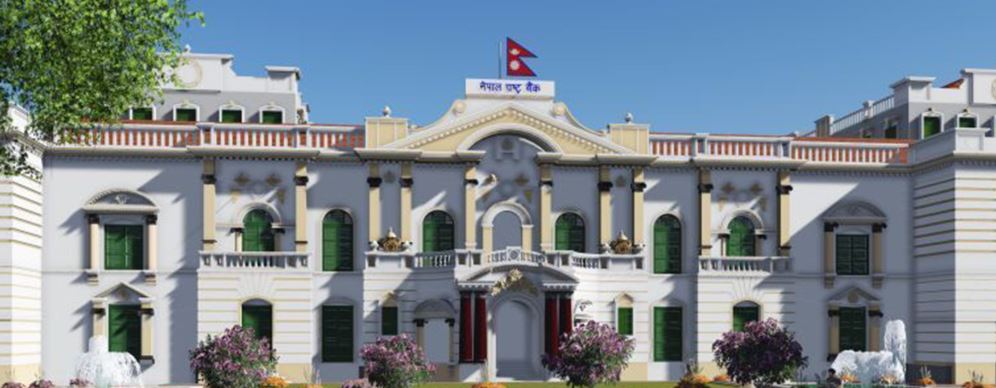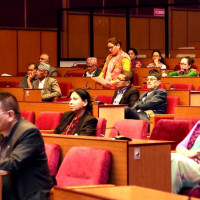- Thursday, 22 May 2025
National economy: Challenges and prospects
By Laxman Kafle,Kathmandu, Apr. 16: Nepal is currently reeling from economic challenges. From Prime Minister Pushpa Kamal Dahal ‘Prachanda’ to the politicians and economists of various hues have frequently been stating that the economy is not in good health.
It is widely assumed that COVID-19 pandemic and the Russian invasion of Ukraine have thrown the global economy out of gear, and Nepal’s has not been an exception either. Their effect has been severer here as Nepal is an import-based economy, and the Russia-Ukraine war as well as the COVID-19 pandemic have badly disrupted the supply system.
Although an improvement has, of late, been witnessed in the external sector, problems in the internal sector have aggravated. Economic activities in the country have almost come to a standstill. Demands have fallen and so are the sales of products.
The industrialists and businessmen came to the streets, probably for the first time in Nepal, against high interest rates imposed by banks and financial institutions on sdloans.
Investment from both the government and the private sectors have fallen, which has brought the private sector’s morale down.
Lack of liquidity, increased bank interest rates along with high inflation driven by the internal and external factors of the economy have affected all sectors, according to economists and businessmen.
Nepal is now passing through the weakest economic situation in history because of the economic problems caused by domestic and international issues, fall in trade and the import restrictions, said economist Dr. Chandramani Adhikari.
“The basic indicators of the national economy such as production, job creation, investment, income and rate of returns are quite weak. Unless a significant improvement is noticed in these indicators, the economy cannot improve internally,” he said.
Revenue mobilisation is so poor that it is insufficient even to meet the general expenditure. Due to dependence on imports and the restriction measures imposed on imports to improve foreign currency reserves, revenue collection has been affected, he said.
There are, however, some positive trends. According to the latest report of the Nepal Rastra Bank, the remittance inflows have increased by 25.3 per cent and reached Rs. 794.32 billion and gross foreign exchange reserves have increased to Rs. 1,401.21 billion by mid-March 2023.
“It is unfortunate to depend only on remittances for more than two-and-a-half years and fail to create employment opportunities and expand
domestic production. If we delay further to retain youth in the country and use them in production, the country’s economy cannot improve and it will fall in crisis anytime when remittance drops due to any reason,” he said.
The share of remittance to GDP now stands at around 23 per cent.
Number of Nepali migrant workers has increased this year. Although this will increase remittances and foreign exchange reserves, this may encourage people to buy imported goods and discourage domestic production.
While addressing two separate conferences -- of FNCCI and NCC -- Prime Minister ‘Prachanda’ said that although the economy of the country was on the course of improvement, it was not completely free from crisis.
He also reiterated the government’s commitment to reduce interest rates and apply all possible efforts for economic reforms.
Moderate growth, pressure on inflation
The national economy has been affected because of the inability to increase production and create employment opportunities in the country for a long time, said Deependra Bahadur Kshetry, former vice-chairman of the National Planning Commission and former governor of Nepal Rastra Bank.
He said there are no alternative to making the internal economy strong by increasing production, job creation and investment to achieve sustainable economic growth.
Inflation is high. According to the latest data of NRB, inflation is at 7.44 per cent. However, consumers have complained that inflation is higher than 10 per cent.
Import cost of goods has been triggered and the Russian invasion of Ukraine has led to soaring inflation as it is a compulsion for the country to import raw materials to produce finished goods to meet the national demand.
Dr. Adhikari said that owing to these challenges, the country will not achieve the targeted economic growth of 8 per cent this year.
In the meantime, the Asian Development Bank and the World Bank have projected Nepal’s economic growth to moderate 4.1 per cent in the current fiscal year due to tight monetary policy, slackened domestic demand, the unwinding of COVID-19 stimulus and persistent global headwinds.
Kamalesh Agrawal, senior vice-president of Nepal Chamber of Commerce, blamed the lack of coordination between the fiscal policy and monetary policy for the current challenges in the economy.
Price hikes of goods and low income have compelled the consumers to reduce their consumption massively.
“Industrialists and businessmen do not have money for investment. Even with improved foreign currency reserves, reduction in the current account deficit, the private sector, which is a major pillar of the economy, is in panic. In such a situation, it is impossible to accelerate economic activities and achieve desired rate of growth,” he said.
He said that the main problem of today’s economy is to adopt only immediate and problem-oriented plans instead of taking a long-term policy to strengthen and sustain the country’s economy.
Difficult to manage expenditure
Increased imports had put pressure on foreign exchange reserves, and the NRB adopted a policy of import ban to shield the economy.
There is a problem in meeting the government expenditure as the revenue does not increase according to the target in every month of the current fiscal year 2022/23. Its direct impact is seen in development and construction sectors.Revenue collection is limited to 48 per cent of the target.
“For the first time, revenue has not been able to cover even the recurrent expenses this year,” said economist Adhikari.
The country collected revenue of Rs. 683 billion while the total expenditure is Rs. 943 billion, resulting in a deficit of Rs. 260 billion. Recurrent expenditure was Rs. 706 billion. According to this, there is a revenue deficit of Rs. 23 billion.
“On the one hand, general expenses have not been covered by the revenue collection and the capital budget has not been spent on the other, “said Agrawal.
The capital expenditure figures are also disappointing as only 28 per cent of the total budget allocated under the capital heading has been spent in the first nine months of the current fiscal year.
Low capital expenditure has created problems in liquidity in banks and financial institutions, affecting the overall economy, he said.
The government has already adopted a measure to cut unnecessary expenditures.
Domestic loan as compared to foreign loan has increased in the country for the first time in the current fiscal year.
It is not a good sign for economy to take more internal loans than foreign loans to recover the budget deficit. This year, the share of internal and foreign loans stood at 49 and 51 per cent.
Migrant workers increase
Recently, the number of people going for foreign employment is increasing day by day. According to the Department of Foreign Employment, around 540,000 people went abroad for jobs within the first eight months of the current fiscal year.
Umakanta Acharya, director general of the Department, said that the number of people going for foreign employment has increased this year compared to pre- COVID-19 time.
According to him, it is expected that the number of people flying overseas as migrant workers will reach 800,000 over the year.
Around 641,000 people went to different countries, especially the Gulf countries for work in the last fiscal year 2021/22. The number was only 167,000 in 2020/21.
Economist Dr. Adhikari said, “The government does not have a clear policy as to how long it will allow the youth to go abroad and run the country from remittance.”
Businessman Agrawal admitted that lack of investment environment and weak investment confidence of domestic and foreign investors in Nepal has been affecting job creation in the country.
Panicked businessmen
When walking around the main market areas of Kathmandu, one can see ‘To Let ‘ boards in many houses and shutters. Such notices are common in major market areas like Durbar Marg, New Road, Baneshwor, Tinkune or Koteshwor. These notices indicate that many people have shut down their businesses.
Naresh Katwal, former president of Nepal National Traders’ Federation, said, “From small grocers to clothing shops, the shutters are empty because the shops are closed.” These empty shutters show that we are already in a recession, he added.
Hotel and restaurant business has also slumped sharply. People are finding it difficult to meet their daily needs due to low income and rising prices.
He said that cooperatives have become the biggest problem for small and medium-sized businessmen.
“Businessmen who run shops used to keep their savings in cooperatives on a daily basis to use money when they needed it. But now, the cooperatives are not ready to return their money for various reasons,” he said.
“In more than 20 years of business experience, I have never seen a downturn in business like this year. Consumption has decreased due to the decline in people’s income,” he said.
Businessman Agrawal said that production of industries has fallen by 40 per cent after the consumption dropped.
Export trade has also decreased by 29 per cent and been limited at Rs. 104 billion by mid-March 2023.
“All the sectors are in problem. Real estate sector is in recession and the investors of the capital market have lost Rs. 1,600 billion which is one third of the total GDP,” said Agrawal.
When the real estate is not sold due to recession in the market, the businessmen are attracting customers by reducing the price of the real estate.
Most of the industrialists and businessmen are unable to pay interest and principal of loans, he said.
According to the data of the Credit Information Bureau, more than 32,000 people and firms have been blacklisted only after the start of the COVID-19 pandemic.
However, businessmen have, of late, seen a ray of hope after the banks started reducing the interest rates an improvement has been seen in liquidity and increase in the flow of tourists in the country.

















